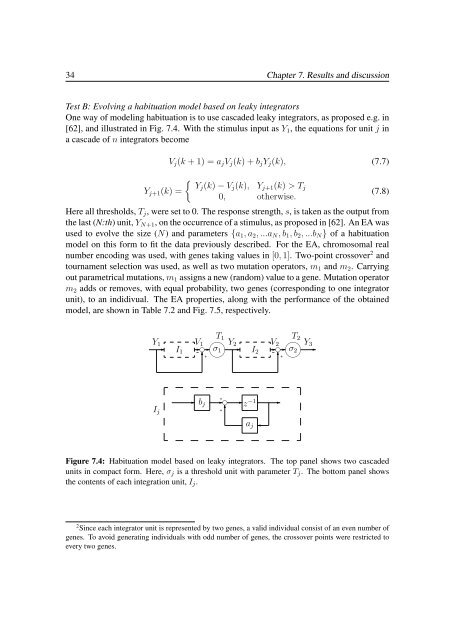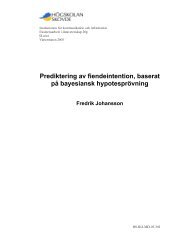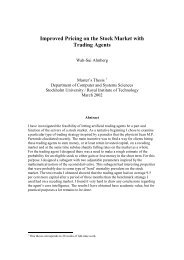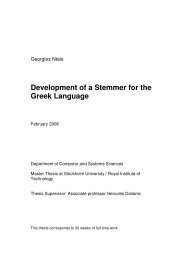Modeling Hydra Behavior Using Methods Founded in Behavior-Based Robotics
Modeling Hydra Behavior Using Methods Founded in ... - SAIS
Modeling Hydra Behavior Using Methods Founded in ... - SAIS
Create successful ePaper yourself
Turn your PDF publications into a flip-book with our unique Google optimized e-Paper software.
34 Chapter 7. Results and discussionTest B: Evolv<strong>in</strong>g a habituation model based on leaky <strong>in</strong>tegratorsOne way of model<strong>in</strong>g habituation is to use cascaded leaky <strong>in</strong>tegrators, as proposed e.g. <strong>in</strong>[62], and illustrated <strong>in</strong> Fig. 7.4. With the stimulus <strong>in</strong>put as Y 1 , the equations for unit j <strong>in</strong>a cascade of n <strong>in</strong>tegrators becomeV j (k + 1) = a j V j (k) + b j Y j (k), (7.7)Y j+1 (k) ={Yj (k) − V j (k), Y j+1 (k) > T j0, otherwise.(7.8)Here all thresholds, T j , were set to 0. The response strength, s, is taken as the output fromthe last (N:th) unit, Y N+1 , on the occurrence of a stimulus, as proposed <strong>in</strong> [62]. An EA wasused to evolve the size (N) and parameters {a 1 , a 2 , ...a N , b 1 , b 2 , ...b N } of a habituationmodel on this form to fit the data previously described. For the EA, chromosomal realnumber encod<strong>in</strong>g was used, with genes tak<strong>in</strong>g values <strong>in</strong> [0, 1]. Two-po<strong>in</strong>t crossover 2 andtournament selection was used, as well as two mutation operators, m 1 and m 2 . Carry<strong>in</strong>gout parametrical mutations, m 1 assigns a new (random) value to a gene. Mutation operatorm 2 adds or removes, with equal probability, two genes (correspond<strong>in</strong>g to one <strong>in</strong>tegratorunit), to an <strong>in</strong>didivual. The EA properties, along with the performance of the obta<strong>in</strong>edmodel, are shown <strong>in</strong> Table 7.2 and Fig. 7.5, respectively.T ✲ ✓✏ 1 TI 1✲ ❡✲ σ1 ✲ ✓✏ 2Y 1 V 1 Y 2 VI 2✲ 2 Y❡✲ σ2 ✲ 3-✻ + ✒✑ -✻ + ✒✑+✲ b j✲ ❡ ✲ z −1 ✲I j + ✻a j ✛Figure 7.4: Habituation model based on leaky <strong>in</strong>tegrators. The top panel shows two cascadedunits <strong>in</strong> compact form. Here, σ j is a threshold unit with parameter T j . The bottom panel showsthe contents of each <strong>in</strong>tegration unit, I j .2 S<strong>in</strong>ce each <strong>in</strong>tegrator unit is represented by two genes, a valid <strong>in</strong>dividual consist of an even number ofgenes. To avoid generat<strong>in</strong>g <strong>in</strong>dividuals with odd number of genes, the crossover po<strong>in</strong>ts were restricted toevery two genes.





